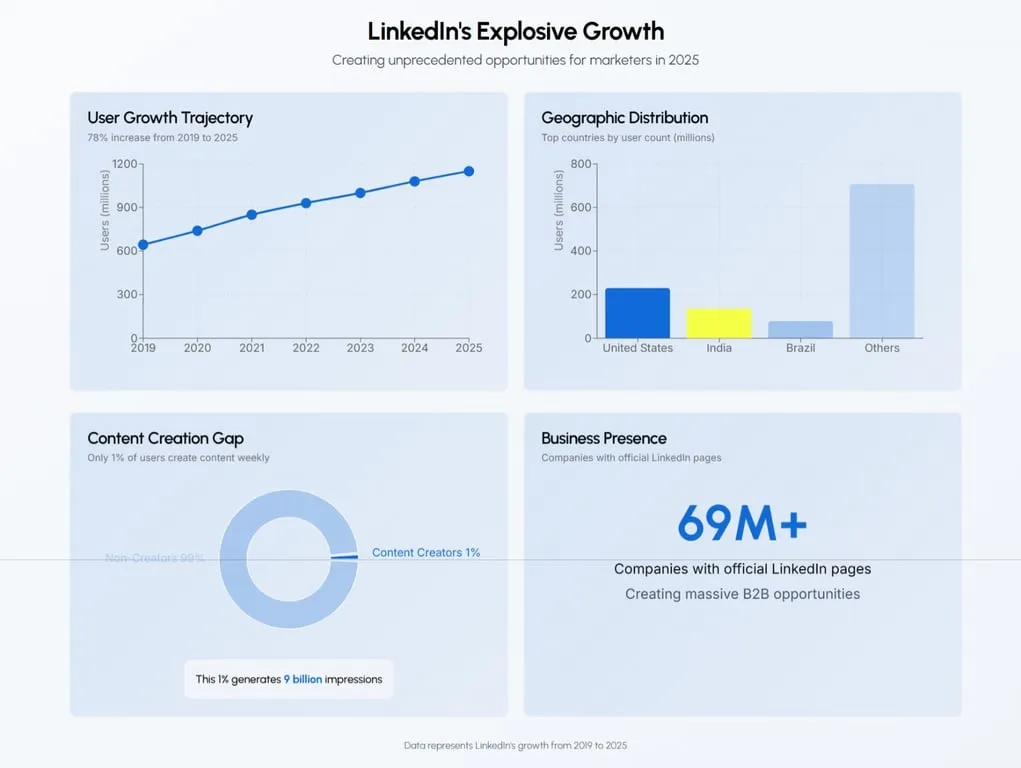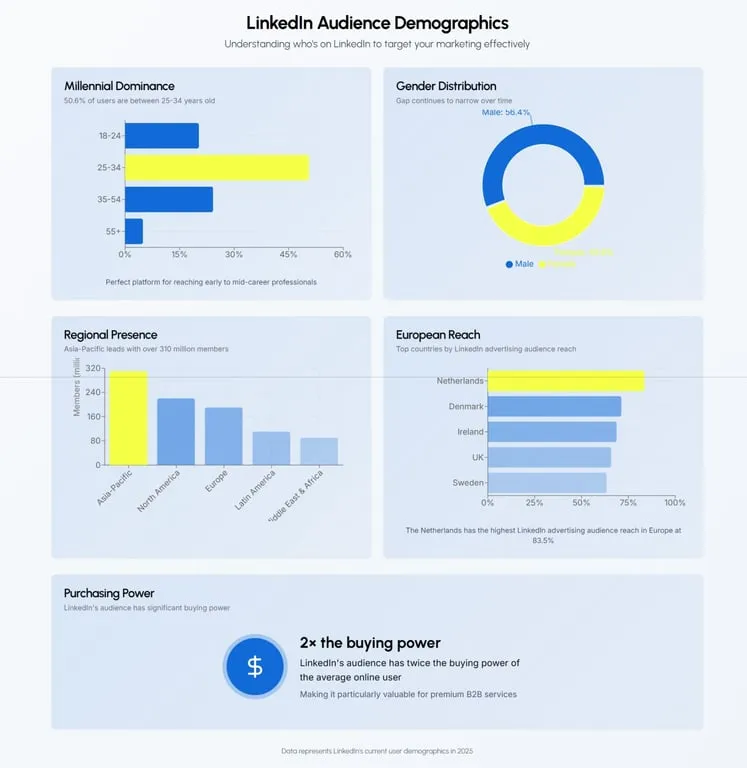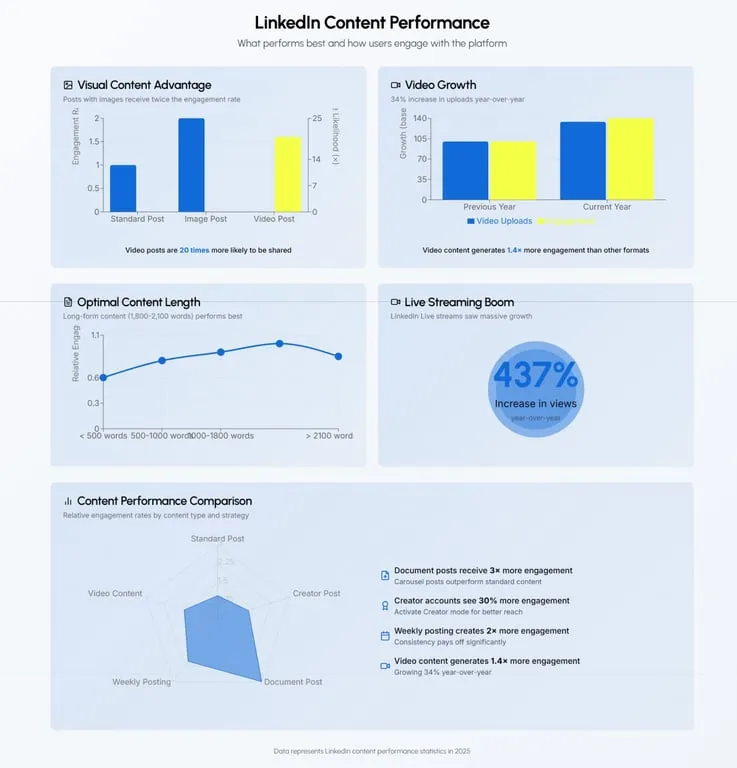As LinkedIn solidifies its position as the undisputed king of B2B marketing, understanding the latest statistics isn't just helpful-it's essential for agency owners and founders looking to make data-driven decisions.
The platform continues to evolve rapidly, with new features, changing algorithms, and shifting user behaviors. What worked in 2024 might not be as effective now.
I've compiled this comprehensive collection of LinkedIn statistics for 2025, organized by category and backed by reliable sources, to help you refine your strategy and maximize your results on the platform.
User Base and Growth Statistics
LinkedIn's explosive growth continues to create unprecedented opportunities for marketers:
-
1 billion+ global users: LinkedIn has surpassed the 1 billion user milestone globally in 2025, with continued user growth of approximately 15% annually.
-
Massive growth trajectory: LinkedIn's user base has grown from 644 million users in 2019 to over 1.15 billion users in 2025-a 78% increase in just six years.
-
Content creation gap: Only about 1% of LinkedIn's monthly users share content weekly, yet these users generate 9 billion impressions. This means consistent content creators have a significant advantage.
-
Business presence: The platform now hosts over 69 million companies with official LinkedIn pages.
-
Geographic distribution: The United States leads with 230 million users, followed by India (135 million) and Brazil (78 million). For a more global approach, check out our guide on regional personal branding approaches.
-

Demographic and Audience Insights
Understanding who's on LinkedIn helps you target your marketing efforts more effectively:
-
Millennial dominance: Millennials dominate LinkedIn, with 50.6% of users between 25-34 years old, making it the perfect platform for reaching early to mid-career professionals.
-
Gender distribution: The platform shows 56.4% male users and 43.6% female users, though this gap continues to narrow.
-
Regional presence: The Asia-Pacific region has the highest LinkedIn membership globally, with over 310 million members.
-
European reach: The Netherlands has the highest LinkedIn advertising audience reach in Europe at 83.5%.
-
Purchasing power: LinkedIn's audience has 2× the buying power of the average online user, making it particularly valuable for premium B2B services.

Engagement and Content Performance
These statistics reveal what content performs best and how users engage with the platform:
-
Visual content advantage: Posts with images receive twice the engagement rate, and video posts are 20 times more likely to be shared.
-
Video growth: Video content has seen a 34% increase in uploads year-over-year, generating 1.4x more engagement than other content formats.
-
Optimal content length: Long-form content (1,800-2,100 words) performs best, achieving higher engagement rates. Learn more about optimizing your content in our LinkedIn post formatting guide.
-
Live streaming boom: LinkedIn Live streams saw a 437% increase in views year-over-year.
-
Creator advantage: Content published by Creator accounts on LinkedIn sees 30% more engagement.
-
Consistency payoff: Businesses that post weekly see a twofold increase in engagement.
-
Document post performance: Document posts (carousels) receive approximately 3x more engagement than standard posts. For optimal results, check our LinkedIn carousel post size guide.

B2B Marketing Impact
LinkedIn's dominance in the B2B marketing space is undeniable:
-
Platform of choice: 96% of B2B marketers use LinkedIn for organic social marketing strategies.
-
Lead generation leader: LinkedIn is the top platform for B2B lead generation, with 40% of B2B marketers indicating it as their most effective channel.
-
Website traffic driver: LinkedIn accounts for 46% of social traffic to B2B websites and is considered the most credible source of content.
-
Lead source dominance: 80% of all B2B social media leads come from LinkedIn.
-
Content marketing platform: 93% of B2B marketers use LinkedIn for content marketing.
-
Conversion power: Marketing on LinkedIn can generate conversion rates that are two times higher than other platforms.
-
Lead conversion effectiveness: LinkedIn has a higher visitor-to-lead conversion rate at 2.74%, nearly three times higher than Twitter and Facebook.
Advertising and Revenue Statistics
LinkedIn's advertising platform continues to grow in both reach and effectiveness:
-
Platform revenue: LinkedIn generated $16.37 billion in revenue in 2024, marking a 9% year-over-year increase.
-
Ad revenue growth: LinkedIn's ad revenue reached $5.93 billion in 2024.
-
Cost per click: The average cost-per-click (CPC) for LinkedIn ads is $5.39, higher in competitive industries like software or consulting.
-
Click-through rates: The average click-through rate (CTR) for LinkedIn ads is 0.62%.
-
Purchase intent impact: Exposure to LinkedIn ads increases purchase intent by 33% and can boost conversion rates by 6× when combined with strong branding.
-
Return on ad spend: LinkedIn ads produced an average return on ad spend (ROAS) of about 113%.
-
Future projections: LinkedIn's ad revenue is projected to reach $10 billion by 2027.
For more on whether LinkedIn Premium is worth the investment, see our comparison of LinkedIn Premium vs. other solutions.
Sales and Lead Generation
LinkedIn has become an essential tool for sales professionals:
-
Lead generation dominance: LinkedIn is the top-rated platform for B2B lead generation, with over 80% of B2B leads sourced through social media coming from LinkedIn.
-
Job search activity: 65 million people use LinkedIn to search for jobs every week.
-
Sales quota impact: Salespeople who engage on LinkedIn are 51% more likely to hit their sales quotas than those who don't.
-
Relationship building advantage: Salespeople who use LinkedIn to build relationships have a Social Selling Index (SSI) score that is 45% higher than those who don't.
For a comprehensive approach to LinkedIn lead generation, read our guide on LinkedIn sales lead generation strategies.
Content and Posting Trends
These statistics reveal how brands and professionals are approaching content creation:
-
Posting frequency increase: Brands on LinkedIn have increased their posting frequency by 10% since 2023.
-
Monthly post average: On average, brands post 18 times per month on the platform.
-
Page engagement: Users visit an average of 7.9 pages per session on LinkedIn.
-
Feed update volume: LinkedIn sessions have increased significantly, with over 443 billion feed updates viewed annually.
-
Active page advantage: Active LinkedIn Pages receive five times more page views than inactive ones.
To optimize your posting schedule, see our research on the best time to post on LinkedIn by industry.
Timing and Scheduling Statistics
When you post can be just as important as what you post:
-
Optimal posting days: Tuesday through Thursday are the most effective days to post on LinkedIn.
-
Peak engagement times: The highest engagement occurs between 8-10 AM and 1-2 PM in your audience's time zone.
-
Content lifespan: LinkedIn posts have a longer shelf life than other platforms, with the average post continuing to receive engagement for up to 48 hours.
-
Diminishing returns threshold: Posting more than once per day shows diminishing returns on engagement.
For more on optimizing your posting schedule, see our guide on why scheduling LinkedIn posts is no longer optional.
Strategic Implications for Marketers
Based on these statistics, here are key strategic takeaways for agency owners and founders:
1. Consistency Trumps Frequency
With only 1% of users creating content but generating 9 billion impressions, there's a significant opportunity for consistent content creators. Focus on quality over quantity-posting weekly can double your engagement.
For help maintaining consistency, check out our guide on creating a LinkedIn content calendar.
2. Diversify Content Formats
The data clearly shows that different content formats perform differently:
-
Document posts (carousels) generate 3x more engagement
-
Video content receives 1.4x more engagement
-
Posts with images get 2x more engagement
Incorporate a mix of these formats into your content strategy rather than relying on text-only posts. For inspiration, see our LinkedIn post ideas that drive engagement.
3. Optimize for B2B Lead Generation
With 40% of B2B marketers citing LinkedIn as their most effective channel and 80% of B2B social media leads coming from the platform, your lead generation strategy should prioritize LinkedIn. Create content specifically designed to nurture prospects through your sales funnel.
Learn more about this approach in our guide on how to optimize your LinkedIn profile for lead generation.
4. Invest in LinkedIn Advertising
Despite higher costs compared to other platforms ($5.39 average CPC), LinkedIn ads deliver strong ROI for B2B companies. The platform's precise targeting capabilities and professional audience justify the investment, with an average ROAS of 113%.
5. Focus on Long-Form Content
With long-form content (1,800-2,100 words) performing best on LinkedIn, consider developing comprehensive articles that showcase your expertise. This content can be repurposed into multiple shorter posts to maximize your content investment.
The Time Challenge: Why Most Marketers Can't Capitalize on These Statistics
Despite the clear opportunities these statistics present, many agency owners and founders struggle to implement a consistent LinkedIn strategy because of time constraints. Creating diverse, high-quality content consistently while juggling client work and business operations is challenging.
This is precisely why we built LiGo:
How LiGo Helps You Implement These Statistical Insights
Theme-Based Content Generation:
Define your content pillars once, then consistently generate ideas aligned with your expertise and audience interests based on what the data shows performs best.
Format Diversification:
LiGo helps you create different content formats-from text posts to carousels-so you can leverage the 3x higher engagement rates of document posts without the design headaches.
Consistency Support:
Schedule posts for optimal times based on these statistics, ensuring you maintain the weekly posting cadence that doubles engagement.
Performance Analytics:
Track which content themes and formats drive the most meaningful engagement with your specific audience, allowing you to refine your strategy based on your own data.
Conclusion: Leveraging LinkedIn's Potential in 2025
The statistics paint a clear picture: LinkedIn continues to dominate the B2B marketing landscape with unparalleled reach, engagement, and conversion potential. For agency owners and founders, the platform offers a unique opportunity to connect with decision-makers, establish thought leadership, and generate high-quality leads.
By understanding these key statistics and implementing a strategic approach to LinkedIn marketing, you can position your agency for success in 2025 and beyond. Focus on consistent, high-quality content creation, leverage diverse content formats, and strategically invest in LinkedIn's advertising capabilities to maximize your results.
Remember that behind these statistics are real professionals seeking valuable insights and meaningful connections. The most successful LinkedIn marketers are those who combine data-driven strategies with authentic engagement and genuine value creation.
For a complete roadmap to LinkedIn success in 2025, see our comprehensive LinkedIn growth roadmap.




